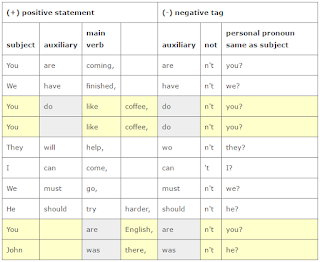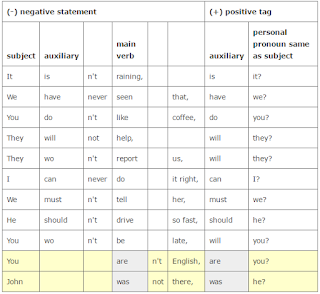Name : Aisyah Rizana Rahmah
NPM : 10213505
Class : 4-EA-18
ACTIVE AND PASSIVE
SENTENCES
Passive Sentences describe a sentences subject is acted upon by the verb. the subject is being acted on by the verb and the
subject typically comes after the action.
In
passive sentences, the thing receiving the action is the subject of the
sentence and the thing doing the action is optionally included near the end of
the sentence. You can use the passive form if you think that the thing
receiving the action is more important or should be emphasized. You can also
use the passive form if you do not know who is doing the action or if you do
not want to mention who is doing the action
But I think the active sentence is a sentence that the
subject is active and related to the object being done and whose sentence does
not need to be accompanied again with the verb while the passive sentence is
the opposite of the sentence that states the subject is not active or doing
activities but must be accompanied again with the verb.
Pattern of Active and passive sentences
·
Active
Sentences
[Thing doing action]+[verb]+[thing receiving
action]
Or
S + V (kata
kerja yang disesuaikan dengan tenses-nya) + O
·
Passive
Sentences
[Thing
receiving action]+[be]+[past participle of verb]+[by]+[thing doing action]
Or
S + be + past participle + (by agent)/O
*by agent : orang yang
melakukan tindakan
Characteristic features of active and passive Sentences
Active Sentences
·
In the
active voice the subject to perform any act directly on the object.
·
Active
sentences pattern S-P-O-K or S-P-K Predicate active sentence always begins with
a particle Me- or Ber-.
·
Active
sentences need the object, Having received the title plus a supplementary
subject or description.
Passive sentences
·
to be + V3
and word-by (the word is not a requirement that must exist in the passive
voice)
·
Which can be
used as a passive sentence is Verbal Sentence (sentence predicate verb / V)
·
Verbal
sentence that can be changed to Passive Voice (passive voice) is a sentence
that has the object of patients.
The
pattern of active and passive voice in the tense
·
If the active voice in the
simple present tense, then 'be' passive voice of his is is, am or
·
If the active voice in
perfect continuous tense, then 'be' passive voice of his is (has / have) been +
being.
·
If the active voice in the
past perfect continuous tense, then 'be' passive voice of his is had been +
being.
·
If the active voice in the
future continuous tense, then 'be' passive voice of his is will be + being.
·
If the active voice in the
past future continuous tense, then 'be' passive voice of his is would be +
being.
·
If the active voice in the
future perfect continuous tense, then 'be' passive voice of his is will have
been + being.
·
If the active voice in the
past future perfect continuous tense, then 'be' passive voice of his is would
have been + being
·
If the active voice in the
simple past tense, then 'be' passive voice of his is was or were
·
If the active voice in the
present perfect tense, then 'be' passive voice of his was been placed after the
auxiliary has or would have, so that a 'has been' or 'have been'
·
If the active voice in the
past perfect tense, then 'be' passive voice of his was been placed after the
auxiliary had, thus becoming had been
·
If the active voice in the
simple future tense, then 'be' passive voice of his is be
·
If the active voice in the
future perfect tense, then 'be' passive voice of his was been placed after the
auxiliary will have, so it becomes 'will have been'
·
If the active voice in the
past future perfect tense, then 'be' passive voice of his was been placed after
the auxiliary would have, thus becoming 'would have been'
·
If the active voice in the
present continuous tense, then 'be' passive voice of his was (is, am or are) +
·
If the active voice in the
past continuous tense, then 'be' passive voice of his is (was or were) + being.
Transitive and Intransitive Verb
·
Transitive
Verb
Transitive verb is
a verb object in the hearts That requires a sentence. The object can be either
a noun, noun phrase, or pronoun.
Example : I Likes Strawberry
Likes
is a transitive verb
Strawberry is a shaped object of noun
·
Intransitive Verb
Intransitive
verb is a verb that does not need the object. Without the presence of the
object to the verb intransitive, it still implies that we can digest.
Example : Peter Crying or He arrived
Peter
and He is a Subject
Crying and Arrived is a Intransitive Verb
We can
equip it with the all sentence with adverb example Peter crying every morning
and He arrived last night.
·
Simple Present Tense
Active :
S + V1 + O
Passive
: S + is/am/are + V3 + ….
Example : A : She writes the memo carefully.
P : The memo is/are written carefully.
·
Simple Past
Tense
Active : S + V2 + O
Passive : S + was/were + V3 + ….
Example : A : She wrote the memo carefully.
P : The memo was/were written carefully.
·
Present
Continues/Progresive
Active : S + is/am/are + V-ing + O
Passive : S + is/am/are + being + V3 + …
Example : A : She is writing the memo carefully.
P : The memo is/are
being written carefully.
·
Past Progresive
Tense/Past Continues Tense
Active : S + was/were + V-ing + O
Passive : S + was/were
+ being + V3 + …
Example : A : She was writing the memo carefully.
P : The memo was being written carefully.
·
Present Perfect
Tense
Active : S + has/have + V3 + O
Passive : S + has/have + been + V3 + …
Example : A : She has writing the memo carefully.
P : The memo has
been writing carefully.
·
Past Perfect
Tense
Active : S + had + V3 + O
Passive : S + had + been + V3 + …
Example : A : She had writing the memo carefully.
P : The memo had
been writing carefully.
·
Auxsallaries/help
Modals + be + V-3
Example : A: She should bring her
phone to call her sister
P : Her phone should be brought by her to call her sister
In my
opinion it easier to make active and passive sentences and change both of the
active sentence into a passive or otherwise use Simple Present Tense because it
uses direct v1 and objects as well as his passive only use is / am / are as its
object and its v3 as a verb. usually the action is happening so much easier to
understand
Passive
question of TOEFL
1. The meeting was supposed to be held yesterday,
but it has been ______ to next Thursday.
A. taken off
B. worn off
C. put off
D. called off
Jawaban : C
Keyword : supposed to be
held yesterday
2. Black, red, and even bright pink diamonds
_____
A. Occasionally to find
B. Occasionally found
C. Have occasionally been found
D. Have occasionally found
Jawaban : C
Keyword : diamonds
3. _____ were first viewed through telescope by
Galileo.
A. Jupiter has four moons
B. Jupiter’s four moons
C. Jupiter surrounded by four moons
D. Surrounded by four moons, Jupiter
Jawaban : B
Keyword : were first
viewed
4. The Supreme Court does not hear a case unless
_____, except those involving foreign ambassadors.
A. A trial
B. Already tried
C. It already trying
D. It has already been tried
Jawaban : D
Keyword : unless
5. _____ occasions for congratulations.
A. Birthdays that usually considered
B. Usually considering birthdays
C. Birthdays are usually considered
D. That considered birthdays usually
Jawaban : C
Keyword : occasions
6. Arabic is studied in Insantama
elementari school. Passive voice
7. They are reading the holy Qur’an.. Active voice
8. These computers are produced in Indonesia. Passive
voice
9. his wallet was fallen. Passive voice
10. Bimo likes to eat banana. Active voice



